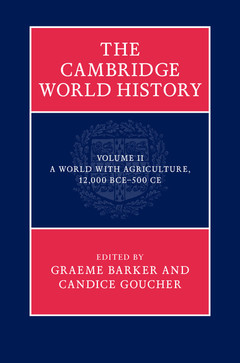Description
The Cambridge World History: Volume 2, A World with Agriculture, 12,000 BCE–500 CE
The Cambridge World History Series
Coordinators: Barker Graeme, Goucher Candice
Explores the origins and impact of agriculture across the globe, arguably the most important change in all of human history.
Language: English
Subject for The Cambridge World History: Volume 2, A World with...:
The Cambridge World History
Publication date: 04-2015
668 p. · 16x23.5 cm · Hardback
Publication date: 04-2015
668 p. · 16x23.5 cm · Hardback
The Cambridge World History: Volume 2, A World with Agriculture, 12,000 BCE-500 CE
Publication date: 11-2017
662 p. · 14.1x22.3 cm · Paperback
Publication date: 11-2017
662 p. · 14.1x22.3 cm · Paperback
Description
/li>Contents
/li>Biography
/li>
The development of agriculture has often been described as the most important change in all of human history. Volume 2 of the Cambridge World History series explores the origins and impact of agriculture and agricultural communities, and also discusses issues associated with pastoralism and hunter-fisher-gatherer economies. To capture the patterns of this key change across the globe, the volume uses an expanded timeframe from 12,000 BCE?500 CE, beginning with the Neolithic and continuing into later periods. Scholars from a range of disciplines, including archaeology, historical linguistics, biology, anthropology, and history, trace common developments in the more complex social structures and cultural forms that agriculture enabled, such as sedentary villages and more elaborate foodways, and then present a series of regional overviews accompanied by detailed case studies from many different parts of the world, including Southwest Asia, South Asia, China, Japan, Southeast Asia and the Pacific, sub-Saharan Africa, the Americas, and Europe.
1. Introduction: a world with agriculture Graeme Barker and Candice Goucher; 2. Archaeogenetics Maria Pala, Pedro Soares, Gyaneshwer Chaubey and Martin B. Richards; 3. Agricultural origins: what linguistic evidence reveals Christopher Ehret; 4. What did agriculture do for us? The bioarchaeology of health and diet Charlotte Roberts; 5. Communities Amy Bogaard; 6. Pastoralism Alan Outram; 7. Agriculture and urbanism Daphne Gallagher and Rod McIntosh; 8. Early agriculture in Southwest Asia Alan Simmon; 9. 'Ain Ghazal (Jordan): a neolithic town prima inter pares Gary Rollefson; 10. Early agriculture in South Asia Eleanor Kingwell-Banham, Cameron A. Petrie and Dorian Q. Fuller; 11. Mehgarh Cameron A. Petrie; 12. Early agriculture in China Xinyi Liu, Dorian Q. Fuller and Martin Jones; 13. Xinglonggou Xinyi Liu, Zhijun Zhao and Guoxiang Liu; 14. Early agriculture in Japan Simon Kaner and Kenichi Yano; 15. The transition from wilderness to paddy: a case study from the Nara basin, Japan, 2600–2400 years ago Kenichi Okada; 16. Early agriculture in Southeast Asia and the Pacific Huw Barton; 17. The swamp cultivators at Kuk: early agriculture in the highlands of New Guinea Tim Denham; 18. Early agriculture in sub-Saharan Africa to c.500 CE Paul Lane; 19. The Tichitt tradition (1900–400 BC): early agriculture and social complexity in the West African Sahel Kevin MacDonald; 20. Early agriculture in the Americas Deborah M. Pearsall; 21. Nanchoc Valley, Peru Tom D. Dillehay; 22. Early agricultural society in Europe Alastair Whittle; 23. Pioneer farmers and frontier households in northern Poland, 5500–4000 BC Peter Bogucki and Ryszard Grygiel.
Graeme Barker is Disney Professor of Archaeology, Director of the McDonald Institute for Archaeological Research and Professorial Fellow, St John's College, University of Cambridge. He is the author of The Agricultural Revolution in Prehistory and Prehistoric Farming in Europe (Cambridge, 1985).
Candice Goucher is a Professor of History at Washington State University, Vancouver. She studied Chemistry and Visual Arts at the University of California, San Diego (B.A., 1975), Art History and Archaeology at Columbia University (M.A., 1978), and African History at the University of California, Los Angeles (Ph.D., 1984). As an undergraduate, she pioneered the use of lead isotope analysis to identify ancient sources of metals, research published in Nature. Trained as an archaeologist, Candice Goucher has conducted archaeological and historical research in the Caribbean, Mauritius, and West Africa, where she worked with Merrick Posnansky at the site of Begho in Brong Ahafo, Ghana, and in the Bassari region of Togo. Her research interests have continued to forge interdisciplinary and global links in the areas of food studies, technology, culture and gender. With Linda Walton, she published several world history textbooks, including the second edition of World History: Journeys from Past to Present (2013) and was co-lead scholar on the Annenberg/Corporation for Public Broadcasting multimedia project Bridging World History. Her recent book Congotay! Congotay! A Global History of Caribbean Food (2014) examined Caribbean agriculture, culture and cuisine from ancient to modern times.
Candice Goucher is a Professor of History at Washington State University, Vancouver. She studied Chemistry and Visual Arts at the University of California, San Diego (B.A., 1975), Art History and Archaeology at Columbia University (M.A., 1978), and African History at the University of California, Los Angeles (Ph.D., 1984). As an undergraduate, she pioneered the use of lead isotope analysis to identify ancient sources of metals, research published in Nature. Trained as an archaeologist, Candice Goucher has conducted archaeological and historical research in the Caribbean, Mauritius, and West Africa, where she worked with Merrick Posnansky at the site of Begho in Brong Ahafo, Ghana, and in the Bassari region of Togo. Her research interests have continued to forge interdisciplinary and global links in the areas of food studies, technology, culture and gender. With Linda Walton, she published several world history textbooks, including the second edition of World History: Journeys from Past to Present (2013) and was co-lead scholar on the Annenberg/Corporation for Public Broadcasting multimedia project Bridging World History. Her recent book Congotay! Congotay! A Global History of Caribbean Food (2014) examined Caribbean agriculture, culture and cuisine from ancient to modern times.
© 2024 LAVOISIER S.A.S.



